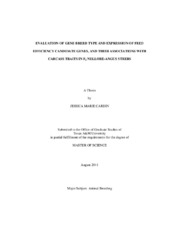| dc.description.abstract | Steers produced in Cycle I of the Texas A & M University McGregor Genomics Project (n = 232, F2 Nellore-Angus) were evaluated for carcass composition, visceral organ weights, and model predicted residual consumption (MPRC), a measure of feed efficiency. Hot carcass weight was strongly correlated with liver weight (r = 0.70, P < 0.001) heart weight (r = 0.58, P < 0.001), and viscera weight (r = 0.55, P < 0.001) but not spleen weight (r = -0.01, P = 0.83). Liver, heart and viscera weights were moderately positively correlated with external and kidney pelvic heart fat (KPH), but not with marbling. None of the organ weights were correlated with MPRC.
A subset of 54 animals was selected for extreme values of residuals of MPRC after a mixed model analysis that included fixed effects of sire and family nested within sire, and these animals were evaluated for insulin-like growth factor I (IGFI) expression in liver samples collected at harvest through quantitative real time polymerase chain reaction (qRT-PCR). IGFI relative quantity (IGFI RQ) was collected from qRT-PCR and was correlated with liver (r = -0.23, P = 0.09), spleen (r = 0.48, P <0.001) and viscera weight (r = 0.24, P = 0.08), but not any carcass trait or MPRC residual.
Gene breed types were determined for 4 candidate genes of feed efficiency: insulin like growth factor-1 (IGF1), leptin (LEP), neuropeptide-Y (NPY) and ghrelin (GHRL). Gene breed types were represented as AA, AN, NA, and NN where A and N denote Angus and Nellore, respectively, and paternal inheritance is listed first. Given that contemporary group significantly influenced most traits (MPRC, all carcass traits, liver weight and viscera weight), effects of gene breed type and contemporary group were evaluated together in analyses. GHRL influenced liver (P = 0.02) and viscera weight (P = 0.02), IGF1 influenced kidney, pelvic, and heart fat (P = 0.05), NPY influenced liver weight (P = 0.03) and hot carcass weight (P = 0.04), and LEP influenced ribeye area (P = 0.05) and hot carcass weight (P = 0.04) with a tendency to influence liver weight (P = 0.06).
Alternate heterozygotes for GHRL were statistically different in liver weight and viscera weight where NA was heavier than AN. Alternate heterozygotes for LEP did not differ in ribeye area, hot carcass weight, or liver weight. Alternate heterozygotes for NPY differed in liver weight (NA heavier than AN), but did not differ in hot carcass weight. Carcasses with AA for LEP and NPY were 18 to 19 kg heavier (P < 0.05) than those with NN, with heterozygotes intermediate. | en |


